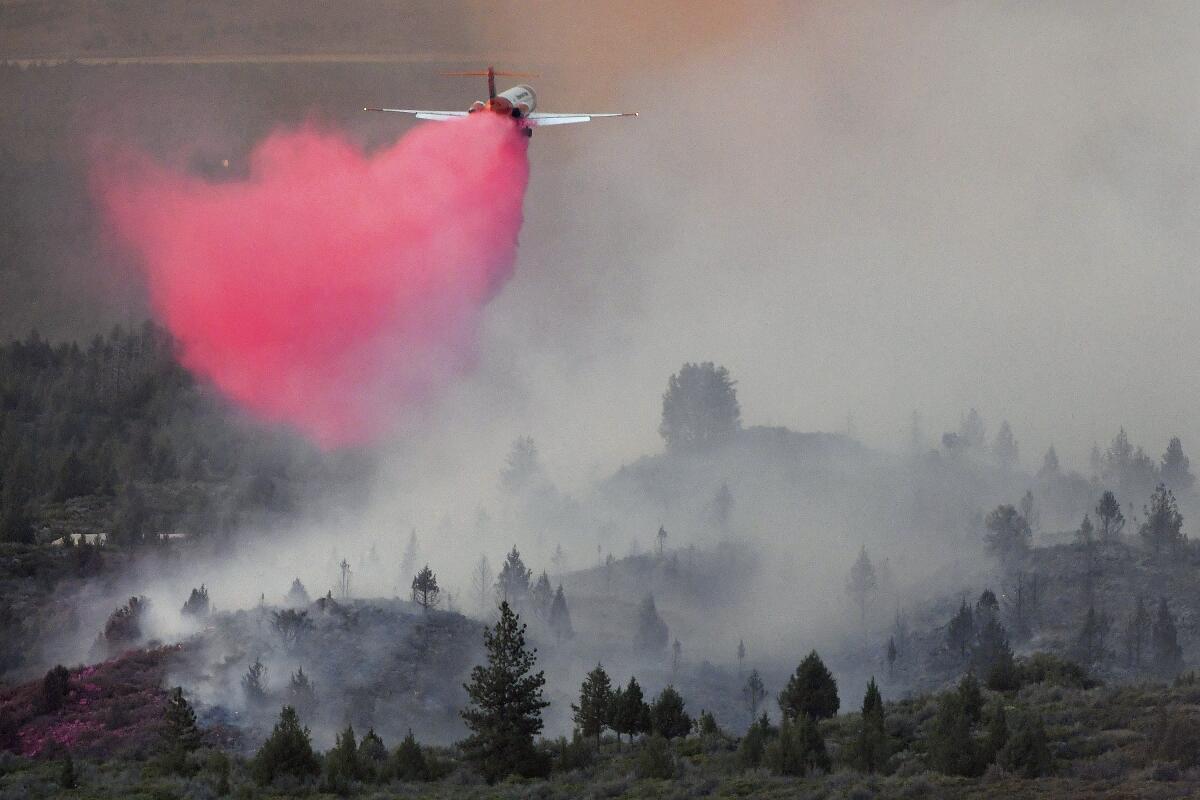As Lava fire grows, two other blazes surge across Northern California forests

- Share via
A trio of fires raging in Northern California have been spurred by bone-dry vegetation, gusty winds and a record-setting heat wave that continues to grip the region.
As the lightning-sparked Lava fire blazes in Siskiyou County, near the Oregon border, a pair of fires — one to the north and one to the south — expanded overnight Wednesday, forcing evacuations and road closures as more firefighters joined the fray.
The Lava fire had swelled to nearly 20,000 acres Thursday, battled by a force of more than 1,200 while temperatures hovered in the upper 90s. It has forced the evacuation of several thousand residents, with gusty red flag conditions fueling flames earlier in the week.
The fire started Saturday morning and on Thursday was 27% contained, according to the U.S. Forest Service.
Crews were making “good progress,” even as challenges remain, said John DeYoe, a public information officer for the California Interagency Incident Management Team 14. Evacuation orders were lifted Thursday evening for the communities of Carrick and Lake Shastina.
Firefighters have gotten a good handle on the northwestern portion of the fire, protecting Weed and other nearby cities.
But the fire continues to slowly make its way around Mt. Shasta. The lava flow areas on the northern part of the mountain are hard to access, and are being attacked mainly by air, DeYoe said, noting that “it’s a danger to firefighters.”
Clare Long, a member of the fire’s incident management team, warned about the use of fireworks during the upcoming holiday weekend.
“Fuels are very, very dry,” she said. “You could have a huge impact on the direction of this fire.... It is very volatile up here.”
While the Lava fire burned, another fire broke out to the south on Wednesday. The Salt fire was reported at 1:55 p.m. east of the Interstate 5 in the Lakehead area of Shasta County, north of Redding, said Suzi Johnson, a spokesperson for the Shasta-Trinity National Forest.
It was initially estimated at 5 acres, but by Thursday afternoon it had ballooned to 4,500 acres with no containment.
Crews worked overnight to keep the fire to the east of the interstate. A few spot fires sprang up west of the highway and lanes were briefly closed Thursday morning.
Officials said Thursday that the Salt fire was caused by a vehicle. According to a statement from the Shasta-Trinity National Forest, a vehicle was traveling north along Interstate 5, past the Gilman Road exit, when “extremely hot materials separated from the vehicle and landed in dry vegetation,” sparking the wildfire.
“Investigators are attempting to locate this vehicle before it causes another fire,” officials said, asking anyone who had seen any disabled or “abnormally slow-moving vehicles” traveling in that area on Wednesday between 1 p.m. and 1:30 p.m. to contact the U.S. Forest Service.
Record heat and dry conditions have set the stage for rapid fire growth, officials said. Wind also has driven the fires.
More of the same is expected, forecasters warned. On Wednesday, Redding reached 100 degrees and saw 5- to 15-mph winds.
“It has been a challenge for the firefighters. They’re still contending with the weather and rugged terrain,” Johnson said Thursday evening. “It’s been a slow go on the ground.”
The Lava fire raging in Northern California had grown to more than 17,000 acres by Wednesday morning, forcing thousands from their homes.
Compounding concerns is the large number of visitors traveling to Lake Shasta for the Fourth of July holiday weekend, Johnson said.
Many of the areas at risk in the Salt fire are near the lake, and firefighters are on high alert.
Portions of the lake remain open, Johnson said, even as land-based and airborne firefighting operations continue around it. On Thursday, “super scoopers” lifted water from the lake to drop on the blaze.
North of both the Salt and Lava fires, wind and boiling temperatures also fueled rapid growth of the Tennant fire. The blaze broke out on the east side of the Klamath National Forest late Monday afternoon near Highway 97 and Tennant Road.
It had grown to more than 9,400 acres by Thursday morning, with 6% containment, said Tom Stokesberry, a Forest Service spokesperson.
Extreme conditions are contributing to the potential for new fires, he said. Temperatures between 95 and 100 degrees and red flag warnings are expected for the holiday weekend. There’s also a chance of dry lightning.
Stokesberry urged the public to stay vigilant while celebrating the holiday. “We want them to enjoy their Fourth of July weekend, but we need their help in making sure no accidental starts happen,” he said.
The plan for Thursday was to continue a direct attack on the fire by more than 270 personnel — with hopes to “get ahead” of the blaze by the end of the day.
The Salt Lake and Tennant fires have prompted a number of evacuation orders and warnings and road closures. An evacuation map was posted by the Siskiyou County Office of Emergency Services.
More to Read
Sign up for Essential California
The most important California stories and recommendations in your inbox every morning.
You may occasionally receive promotional content from the Los Angeles Times.












